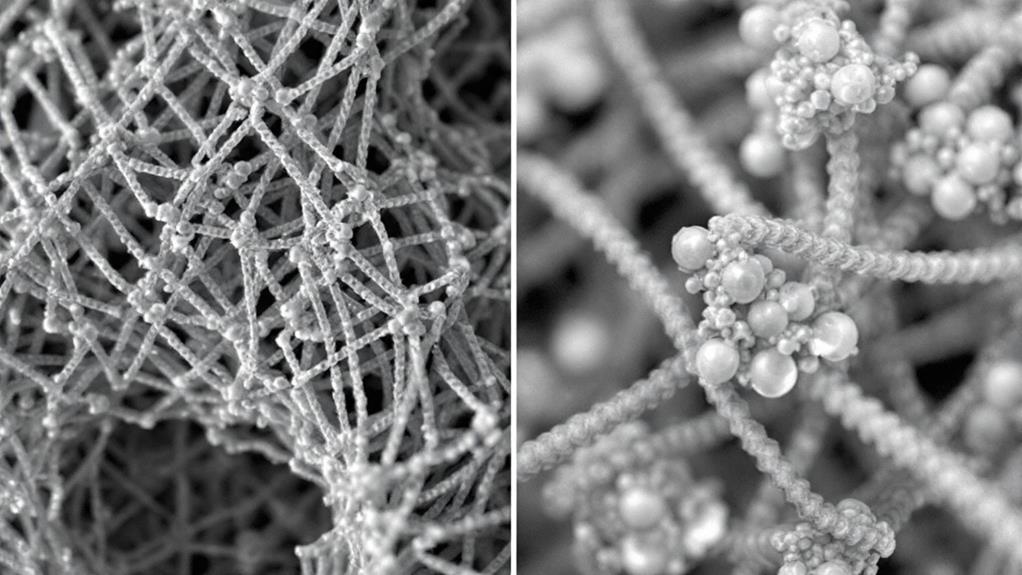Interesting Facts About Nanomaterials: The Future of Tiny Technology

Nanomaterials are revolutionizing technology at the atomic scale. These tiny particles, typically 1-100 nanometers in size, exhibit unique properties that differ from their larger counterparts. You'll find gold nanoparticles appearing red or purple, and carbon nanotubes 100 times stronger than steel but six times lighter. In medicine, nanoparticles enable targeted drug delivery and enhanced imaging. They're enhancing energy production in solar panels and batteries, while creating self-cleaning surfaces that repel dirt and water. From stronger materials to more efficient energy systems, nanomaterials are shaping the future of countless industries. The potential applications of this tiny technology are truly mind-boggling.
Defining the Nanoscale
Visualize a grain of sand. Now imagine something a million times smaller. You've just entered the nanoscale, where materials exhibit unique properties and behaviors. The nanoscale typically ranges from 1 to 100 nanometers, with a nanometer being one billionth of a meter. At this level, you're dealing with dimensions close to the size of atoms and molecules.
The nanoscale's boundaries aren't strictly defined, but they're generally considered to be the point where materials begin to display different characteristics from their bulk counterparts. This is due to quantum effects and the increased surface area-to-volume ratio at these tiny dimensions. Understanding the atomic structure of materials becomes vital at this scale, as it directly influences their properties.
When you work with nanomaterials, you're manipulating matter at its most fundamental level. This allows for the creation of materials with enhanced strength, conductivity, or reactivity. The nanoscale bridges the gap between individual atoms and bulk materials, opening up a world of possibilities for technological advancements in fields like electronics, medicine, and energy production.
Unique Properties at Nano Levels
As we zoom in to the nanoscale, a fascinating world of unique properties emerges. Materials that behave one way at the macro level can exhibit completely different characteristics when reduced to nanosize. This is where quantum effects come into play, dramatically altering the physical, chemical, and biological properties of materials.
You'll find that nanoscale behavior often defies classical physics. For instance, gold nanoparticles appear red or purple, not gold. They also melt at lower temperatures than bulk gold. Carbon nanotubes are incredibly strong yet lightweight, while quantum dots can emit different colors based on their size.
These unique properties stem from the increased surface area-to-volume ratio and quantum confinement effects. As particles shrink, a larger proportion of atoms are found at the surface, leading to enhanced reactivity. This phenomenon has exciting implications for catalysis, drug delivery, and energy storage.
Moreover, nanomaterials can exhibit superparamagnetism, increased electrical conductivity, and improved optical properties. These characteristics open up possibilities for advanced sensors, electronics, and medical treatments that weren't feasible with conventional materials.
Revolutionary Applications in Medicine

Countless revolutionary applications in medicine have emerged from the unique properties of nanomaterials. You'll find these tiny particles at the forefront of drug delivery systems, boosting the precision and effectiveness of treatments. Nanoparticles can be engineered to target specific cells, supplying medications directly to diseased areas while minimizing side effects on healthy tissues.
In tissue engineering, nanomaterials are reshaping how we repair and regenerate damaged organs and tissues. They're used to create scaffolds that mimic natural cellular environments, promoting better cell growth and integration. You'll see this technology applied in bone and cartilage repair, as well as in the development of artificial organs.
Nanomaterials are also revolutionizing diagnostic tools, enabling earlier and more accurate disease detection. They're enhancing imaging techniques like MRI and CT scans, providing clearer and more detailed results. Additionally, you'll find nanoparticles in biosensors that can detect minute amounts of disease markers in blood or other bodily fluids, potentially catching illnesses before symptoms appear. These advancements are opening the door for personalized medicine, where treatments can be customized to your unique genetic makeup and health conditions.
Enhancing Energy Production
Nanomaterials are revolutionizing energy production by enhancing efficiency and sustainability across various sectors. You'll find these tiny particles making a big impact in solar panels, where they're improving light absorption and conversion rates. Nanostructured materials are also boosting the performance of wind turbines by creating stronger, lighter blades that capture more energy from the wind.
In the domain of energy storage capabilities, nanomaterials are transforming batteries and supercapacitors. They're enabling faster charging times, longer lifespans, and higher energy densities. This advancement is essential for electric vehicles and grid-scale energy storage, supporting renewable energy integration.
Fuel cells are another area where nanomaterials shine. They're enhancing catalytic activity, improving efficiency, and reducing the need for expensive precious metals. In nuclear energy, nanoparticles are being used to develop safer, more efficient reactors and improve waste management.
Nanomaterials are also playing a role in thermoelectric devices, converting waste heat into electricity. This technology could drastically increase the overall efficiency of power plants and industrial processes, reducing energy waste and greenhouse gas emissions.
Stronger and Lighter Materials

Strength and lightness converge at the nanoscale, revolutionizing material science. You'll find that nanomaterials offer exceptional combinations of properties that were once thought impossible. By manipulating materials at the molecular level, scientists can create structures with improved structural integrity and increased wear resistance.
Carbon nanotubes, for instance, are 100 times stronger than steel but six times lighter. They're being used to reinforce composites in aerospace, automotive, and sports equipment industries. You'll see these materials in everything from aircraft fuselages to tennis rackets, providing strength without the weight penalty.
Graphene, another wonder material, is a single layer of carbon atoms arranged in a hexagonal lattice. It's incredibly strong, flexible, and conductive. You'll find it enhancing the performance of batteries, electronics, and even clothing.
Nanoceramics are pushing the boundaries of what's possible in extreme environments. They're heat-resistant, corrosion-resistant, and incredibly hard. You'll see them in cutting tools, engine components, and protective coatings, extending the life of various products.
These stronger and lighter materials are changing industries, enabling new designs and improving efficiency across the board.
Self-Cleaning Surfaces
A notable innovation in nanomaterials is the development of self-cleaning surfaces. These surfaces use microstructural modifications to repel dirt, water, and other contaminants, making them easier to maintain and more hygienic. By manipulating surface wettability control at the nanoscale, scientists have created materials that mimic nature's self-cleaning properties, like lotus leaves.
You'll find self-cleaning surfaces in various applications:
- Windows that stay clear without frequent washing
- Fabrics that resist stains and odors
- Solar panels that maintain efficiency by shedding dust
- Bathroom fixtures that prevent bacterial growth
- Exterior paints that keep buildings looking fresh longer
The technology behind these surfaces often involves creating nanoscale structures that trap air pockets, preventing liquids from adhering. This superhydrophobic effect causes water droplets to bead up and roll off, taking dirt particles with them. In some cases, photocatalytic nanoparticles are used to break down organic matter when exposed to light.
As research progresses, you can expect to see more widespread use of self-cleaning nanomaterials in everyday products, reducing the need for harsh cleaning chemicals and saving time and resources in maintenance tasks.
Environmental Impact of Nanomaterials

Over the past decade, the widespread adoption of nanomaterials has raised concerns about their environmental impact. As these tiny particles find their way into various products and industrial processes, you might wonder how they affect our ecosystems and human health.
One of the primary issues is the lack of key ecological impact assessments for many nanomaterials. Scientists are still studying how these particles interact with living organisms and ecosystems over time. Some nanoparticles can accumulate in soil and water, potentially disrupting food chains and altering habitats.
Waste disposal concerns are another significant aspect of nanomaterial use. Traditional recycling and waste management systems may not be equipped to handle these microscopic particles effectively. As a result, nanomaterials could end up in landfills or water bodies, posing risks to wildlife and potentially entering the human food supply.
You should be aware that while nanomaterials offer incredible benefits in various fields, their long-term environmental effects remain uncertain. Researchers are working to develop safer nanomaterials and improved disposal methods to mitigate potential risks. As consumers, it's vital to stay informed about the products you use and support companies that prioritize environmental responsibility in their nanomaterial applications.
Challenges in Nanomaterial Production
While environmental concerns are significant, the production of nanomaterials itself poses unique challenges. You'll find that manufacturing scalability is a major impediment in the nanomaterial industry. As demand grows, producers struggle to maintain consistent quality and properties when scaling up from laboratory to industrial production. Regulatory compliance adds another layer of complexity, with evolving safety standards and guidelines that vary across regions.
You're likely to encounter these challenges in nanomaterial production:
- Precise control of particle size and distribution
- Preventing contamination during synthesis
- Ensuring uniform dispersion in composites
- Developing cost-effective production methods
- Implementing adequate safety measures for workers
The nanoscale nature of these materials requires specialized equipment and highly controlled environments. You'll need to invest in advanced characterization techniques to verify the quality and properties of your nanomaterials. Additionally, you'll face the challenge of developing new testing methods to assess the safety and performance of these materials in various applications. As you manage these obstacles, you'll find that collaboration between researchers, manufacturers, and regulatory bodies is indispensable for overcoming the challenges in nanomaterial production and advancing this promising field.
Future Prospects of Nanotechnology

As nanotechnology continues to progress at a rapid pace, you'll find its future possibilities both thrilling and revolutionary. In the coming years, you'll witness the development of miniaturized computing devices that can be implanted in your body, monitoring your health and providing targeted treatments. These nanoscale machines will revolutionize medicine, potentially eradicating diseases and extending human lifespans.
You'll also see nanotechnology altering various industries. Advanced sensing capabilities will lead to ultra-precise environmental monitoring, helping combat climate change and pollution. In manufacturing, nanorobots will assemble products atom by atom, reducing waste and energy consumption. The energy sector will benefit from more efficient solar cells and batteries, making renewable energy more accessible and affordable.
Nanotechnology will reshape your daily life too. You'll have access to self-cleaning surfaces, smart fabrics that adapt to temperature changes, and unbreakable, flexible electronics. In agriculture, nanotech will enhance crop yields and reduce pesticide use. As these innovations unfold, you'll need to ponder the ethical implications and potential risks associated with this powerful technology.



